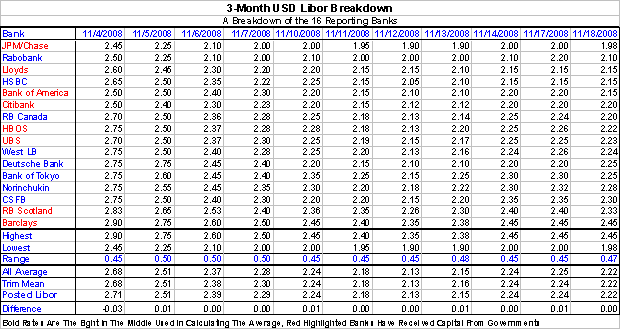
- MarketBeat (WSJ Blog) – Libor Stabilizes, But Not How the Market Wants
The good news about Libor, the key interbank lending rate, is this: it’s stabilizing. The bad news is that it is stabilizing at rates that cannot in any way be considered normal. Libor, sort of a traded version of the federal funds rate, is a measure of how much it costs for one bank to borrow from one another. Until the latter part of 2007, generally the rate to borrow funds for a short period (anywhere from overnight to three months) was 0.1 to 0.15 percentage point more than the federal-funds rate. Amid the bankruptcy of Lehman Brothers, this difference exploded, eventually peaking around October 8, when the cost of borrowing money from another bank for three months rose to 4.52%, or a ridiculous 3.22 percentage points more than the expected federal-funds rate, which at the time was 1.30%, according to Ried Thunberg ICAP.
Comment This article brings up a good point. With LIBOR stabilizing nearly 200 basis points above the 3-month T-bill rate, it is still at what would have been considered a panic level any time before Labor Day. Just because current rates “look good” relative to the levels of early October does not mean this market is well.
Further, as we have been highlighting, LIBOR and commercial paper are what we called “medicated markets.” Government involvement (medication) is so large in these markets that it is almost questionable whether they can still be considered markets. Who is buying term commercial paper other than the Federal Reserve? If investors are not buying, is it still a market? Over half the banks that report LIBOR are receiving government assistance (marked in red in the table above), and they are being told publicly to “do something” about the high level of LIBOR. Furthermore, with over $1 trillion in Term Auction Facilities (TAF) and swap agreements designed to manipulate LIBOR, can we honestly consider this a freely traded market?
Given the high level of manipulation from the Federal Reserve/Treasury, we believe it is impossible to say if these “markets” are getting better. Only when government involvement subsides and these rates can stand on their own can we say things are getting better. Currently, these markets are a long way from this happening.